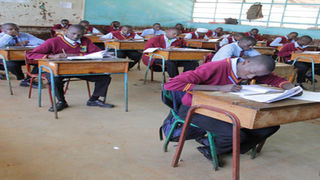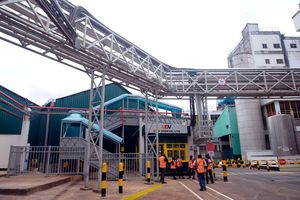
Form four students at Nyeri High School in final preparations for the 2013 KCSE exams.
|Education
Premium
Policy failure? 194,000 learners didn’t sit KCSE
What you need to know:
- Ministry yet to provide explanation for huge difference.
- Education ministry has implemented 100pc transition policy since 2017.
More than 194,000 learners who completed Standard Eight four years ago did not sit the 2020 Form Four examinations, bringing into question the success of the much-touted 100 per cent transition policy.
While Kenya National Examination Council (Knec) reported that 752,602 candidates registered for the 2020 Kenya Certificate of Secondary Education (KCSE) examinations, 942,021 candidates sat for Kenya Certificate of Primary Education (KCPE) examinations in 2016.
In addition, 5,441 candidates who registered for KCSE last year missed the tests as records show only 747,161 candidates wrote the exams. Their no-show has been attributed to consequences of the Covid-19 pandemic.
However, Education Cabinet Secretary George Magoha did not explain the whereabouts of the 189,419 learners (93,176 boys and 101,684 girls) who should have transitioned to secondary schools in 2017.
The class of 2020 was the pioneer lot of the 100 per cent Form One transition policy.
Possible explanations for this difference include early pregnancies, early marriages, drug and substance abuse, lack of school fees and juvenile delinquency.
Highest dropout rate
An analysis of data from Knec on the 2016 KCPE and 2020 KCSE candidates reveals that the counties with the highest dropout rate were Kwale, Kilifi, Tana River and Marsabit. However, it should be noted that some of the students could have moved to schools in other counties.
In Kwale, the candidates who sat the KCPE exam but missed the KCSE one are 8,109. Only 7,068 candidates sat for KCSE, against 15,177 who sat for KCPE exams in 2016. In Kilifi, 30,225 candidates sat the KCPE exam in 2016 but only 15,832 took last year’s KCSE tests, leaving 14,393 learners unaccounted for.
Tana River County had 57 per cent of learners who sat for KCPE four years ago miss last year’s KCSE exam. Of the 4,111 learners who sat the KCPE exam in 2016, only 1,752 took the 2020 KCSE exam.
Out of the 3,980 candidates who sat for KCPE in Marsabit County in 2016, only 2,033 did the KCSE exam, a shortfall of 1,947 or 49 per cent. Nairobi County had 52,745 KCPE candidates in 2016 and 29,419, in the 2020 KCSE. The drop was attributed to few secondary schools in the city.
Other counties where the number of candidates had dropped four years later are Lamu (1,591), Isiolo (1,464), Samburu (2,458), Mandera (4,111) and Wajir (4,542).
Counties in the Coast and North Eastern regions have featured prominently in the list of regions with high incidences of early pregnancies and marriages.
100 per cent transition policy
The data also shows that there are counties that posted more candidates in the 2020 KCSE exams than those who did KCPE exams in 2016. These are Murang’a, which had 2,200 more candidates, and Tharaka-Nithi, with 714. This is attributed to admissions from other counties.
The the 100 per cent transition policy was implemented through chiefs and primary school head teachers who were tasked with ensuring all pupils who had completed Standard Eight in 2016 joined secondary schools.
The government moved to create more space for the learners in secondary schools, issuing a Sh6.4 billion grant to 2,710 regular and 30 special needs secondary schools. A total of 349 laboratories and 326 sanitation blocks had also been completed in various schools by the end of 2017.
In 2018, the government introduced day wings in 19 national schools in Nairobi was meant to maximise the use of resources as well as delink admission from bed capacity.
The schools included Kenya High School, Starehe Boys Centre, Moi Forces Academy, Nairobi School, Lenana School, Pangani Girls and Moi Girls Secondary School, Nairobi.
However, the programme collapsed after a year when the day scholars joined boarding schools.





